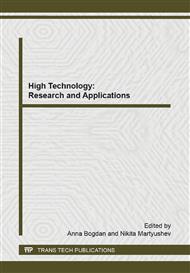[1]
H. Tian, Z. Tang, X. Zhuang, X. Chen, X. Jing, Biodegradable synthetic polymers: Preparation, fictionalization and biomedical application, Progr. Polym. Sci. 37 (2012) 237-280.
DOI: 10.1016/j.progpolymsci.2011.06.004
Google Scholar
[2]
F. Poncin-Epaillard, O. Shavdina, D. Debarno, Elaboration and surface modification of structured poly(L-lactic acid) thin film on various substrates, Mater. Sci. Eng. 33 (2013) 2526-2533.
DOI: 10.1016/j.msec.2013.02.010
Google Scholar
[3]
S.I. Tverdokhlebov, E.N. Bolbasov, E.V. Shesterikov, A.I. Malchikhinа, V.A. Novikov, Y.G. Anissimov, Research of the surface properties of the thermoplastic copolymer of vinilidenefluoride and tetrafluoroethylene modified with radio-frequency magnetron sputtering for medical application, Appl. Surf. Sci. 263 (2012).
DOI: 10.1016/j.apsusc.2012.09.025
Google Scholar
[4]
L.I. Kravets, S. N. Dmitriev, A. B. Gil'man, Modification of Properties of Polymer Membranes by Low-Temperature Plasma Treatment, High Ener. Chem., 43 (2009) 181–188.
DOI: 10.1134/s0018143909030059
Google Scholar
[5]
T. Demina, D. Zaytseva-Zotova, M. Yablokov, A. Gilman, T. Akopova, E. Markvicheva, A. Zelenetskii, DC discharge plasma modification of chitosan/gelatin/PLLA films: Surface properties, chemical structure and cell affinity, Surface & Coatings Technology 207 (2012).
DOI: 10.1016/j.surfcoat.2012.07.059
Google Scholar
[6]
A.B. Gil'man, Low-Temperature Plasma Treatment as an Effective Method for Surface Modification of Polymeric Materials, High Energy Chemistry, 37 (2003) 17–23.
Google Scholar
[7]
N. De Geyter, A. Sarani, T. Jacobs, A. Yu. Nikiforov, T. Desmet, P. Dubruel, Surface Modification of Poly-e-Caprolactone with an Atmospheric Pressure Plasma Jet, Plasma Chem Plasma Process 33 (2013) 165–175.
DOI: 10.1007/s11090-012-9419-3
Google Scholar
[8]
W. Liu, J. Zhan, Y. Su, T. Wu, C. Wu, S. Ramakrishna, X. Mo, S.S. Al-Deyab, M. El-Newehy, Effects of plasma treatment to nanofibers on initial cell adhesion and cell morphology, Coll. Surf. B: Biointerfaces 113 (2014) 101-106.
DOI: 10.1016/j.colsurfb.2013.08.031
Google Scholar
[9]
K. Owens, R.C. Wendt, Estimation of surface free energy of polymers, J. Appl. Polym. Sci. 13 (1969) 1741D-1747D.
Google Scholar
[10]
R. Morent, N. Geyter, T. Desmet, P. Dubruel, C. Leys, Plasma Surface Modification of Biodegradable Polymers: A Review, Plasma Process. Polym. 8 (2011) 171-190.
DOI: 10.1002/ppap.201000153
Google Scholar


